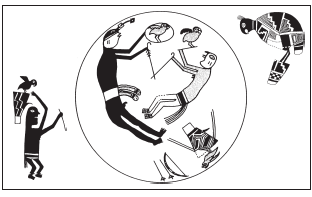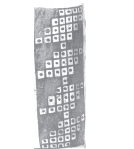 |
 |
 |
||||
| “One yin, one yang, that is the Tao.” This quotation is the first known reference to Yin and Yang, the pair of polar energies whose cyclic fluctuations and interactions cause and govern Creation. Yin is the moon, water, and earth. Yang is the sun, fire, and heavens. Yin corresponds to the dark, the receptive, the passive, the feminine. Yang corresponds to the bright, the creative, the active, the masculine. This is a dynamic symbol showing the continual interaction and balance of the two energies, and as such it is a very harmonizing symbol. As each of these energies reaches its apogee, it begins to transform into its opposite, and this is shown by the dots in the symbol. At its height, yang contains the seed of yin, just as yin contains the seed of yang. “Everything has yin and yang in it and from their rise and fall coupling comes new life.” Tao-te Ching by Lao-tzu |
||||||
| Fertilizer Rosetta Stone Illustration Interpreted by Tarahumara Ethnographic Evidence Male Sky God with “stepfret” lightening legs. Three Rivers Petroglyph. Permission granted Joe Ben Sanders. Monumental art-female fertile rain attractor. Practical application is the making of fertilizer from a mix of rain associated with lightning and detritus/waste materials in what I now call a fertilizer dehydration basin (right) Wupatki Basin. Permission granted Adriel Heisey. |
||||||
 |
||||||
 |
||||||
| Charles DiPeso examines the obvious male/femaile relationship with the Macaw enclosure doorways. I propose this again, is the basic symbolism used for the dualistic nature that was revered by the Pre-Columbian Oasis America cultures. |
 |
|||||
| The Mimbres polychrome representation (above) shows the “vision quest” sky deity delivering the macaw in an enclosed seed casing through the “staff(s) of authority” to the earth female deity, as the macaw enters the natural sphere of existence. Notice the strong step-fret design pattern associated with the separate macaw on carrying basket and with the kokopelli macaw trader. Paquimé archaeologist (Charles DiPeso) is shown (right) with anthropomorphic male “plug” from the stone birth canal of the ceremonial macaw birthing chambers. These enclosures have been previously interpreted as macaw nesting boxes. It is noted, however, that macaws are very unlikely to breed and nest under the conditions illustrated in the lower right photographs. The original interpretation given here is that the macaws exit mother earth during major religious ceremonies, most likely at the spring equinox. As they walk into the light they are lifted by the priest to greet the father sky. The “macaw stones” or doors to parrot pens show an isomorphic patterning with ballcourt distribution (Whalen and Minnis 1996). Our interpretation is that many of the architectural structures identified as “ballcourts” are actually fertilizer dehydration basin. The macaw stones were used as water control devices in this context and also have the religious connotation of releasing the fertile water, thereby completing the rainwater/fertility cycle for the corn crop. This is a completely new concept, and as far as is known, the actual layout and design of the fertilizer dehydration basin relating to the macaw stone cannot be understood without further study. |
||||||
 |
||||||
 |
||||||
 |
||||||
copyright 2005 - Richard D Fisher - DigitalTeamWorks.com